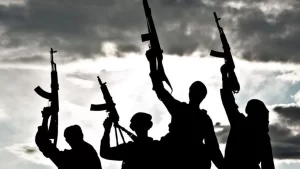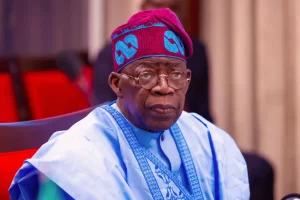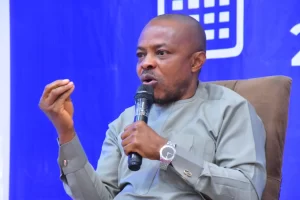FLASHBACK NEWS : THE QUEEN VISITED NIGERIA

In 1956, Nigeria was owned by Queen Elizabeth.
In the years between 1600 and 1800, the world was a massive battle field for warriors: the Black and the White. But it became lopsided against the Black when in 1718, James Puckle of England demonstrated his new invention; the Puckle Gun, a tripod-mounted, single-barrel flintlock gun, fitted with a multi-shot revolving cylinder. This weapon fired nine shots per minute. Then came the “Gatling (machine) Gun” invented in 1861 by Doctor Richard Jordan Gatling, a six-barrel weapon capable of firing a (then) phenomenal 200 rounds per minute.

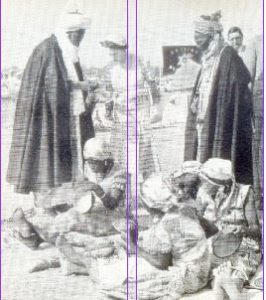
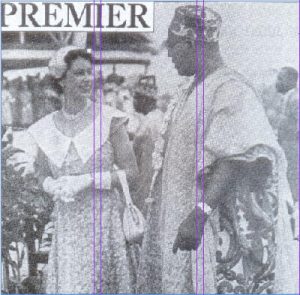
And the Black had no more answer to the White’s encroachment, assault and subjugation, for it was one of these guns mounted on the Royal Navy ship called HMS Prometheus, anchored on the lagoon on 8 August, 1861, that was used to coerce Oba Dosumu of Lagos into ceding his kingdom to the British.
It was the first leg put forward by the British to annex this area of the Niger and by 1900, this had been completed and since then, the British monarch became the owner of Nigeria. Thus in 1956, the owner of Nigeria then was the Queen and in her condescension, Queen Elizabeth announced that she would visit Nigeria between 28 January and 15 February, 1956 and the nation became anxious, waiting for its mother; for it was the first national celebration in Nigeria.
Before then, the only unified celebration that could be called national was the Empire Day. It was the day to sing the only anthem known to school children and civil servants. It was the day to recite “God save the Queen” and most children even believed that the Queen was the representative of the God Almighty in Nigeria. And, indeed, she was a small god!
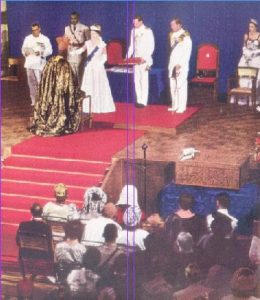
Now, the small god was visiting January 1956. As she prepared to leave, the bitter cold and misty weather in London could not prevent hundreds of Nigerians, dressed in flowing national dresses from turning up at the airport to bid the Queen and the Duke of Edinburgh farewell. Mr. Matthew Mbu, Federal Commissioner of Nigeria and Chief M. E. R. Okorodudu, Mr. O. C. Ojiako and Alhaji Abdul Malik, Commissioners for Western, Eastern and Northern Nigeria respectively, were among the crowd.
Nigerians’ style of festivity did not start today. Around 4 p.m. on that Friday, 27 January, 1956, a Nigerian band from a London night club played highlife and O-wa-nbe, including a song composed for the Queen, who, dressed in a warm white-mink coat and black hat, inspected a guard of honour and spoke to cabinet ministers including Mr. A. T. Lennox-Boyd, Colonial Secretary. And at 5.07 p.m., the aircraft took off and began its 3,500-mile journey to Lagos.
The Queen Arrived
Lagos itself could not sleep this Saturday, 28 January, 1956. What a day it had been! The Queen had come to Nigeria in all her charming glory and all had received her with open arms. The country’s leaders assembled in all their finery at the Ikeja Airport to welcome Her Majesty and the Duke of Edinburgh, while the ordinary people of the country gathered at the airport and along all the routes into Lagos to give their delighted cheers.
It was a day of pomp and ceremony, a day of happiness and good humour. Crowds were milling around the routes, while at the Airport, the scene was one of excitement and anticipation.
At half past eight, “A” Troop of the 1st Field Battery, West African Artillery, took up position at the edge of the runway with their guns, ready to boom out their royal salute when the Queen arrived. Soon after, vehicles were leaving Lagos with the Governor-General, Sir James Robertson, Federal ministers and other personalities, who were attending the airport or Yaba roundabout ceremonies.
At the airport, all eyes turned sky-wards as a BOAC plane approached. This was bringing in members of the Royal Household. Then, with the noise of their engine reverberating across the airfield, six Canberra jet bombers took off in readiness for their fly-past.
The waiting crowd then saw the Second Battalion of the Nigeria Regiment march on to the apron of the airport. What a fine show they made with their officers in white and their band, playing brisk martial music in the bright sunshine.
Then in the sky appeared a speck which came nearer to reveal itself and as the Queen’s plane circled overhead, the crowd grew silent in anticipation of the great moment that laid ahead. At 9.53 a.m., the Royal Aircraft, a spick and span BOAC Argonaut, touched down. Slowly and with two engines cut off, it moved over towards its appointed place and then stopped.

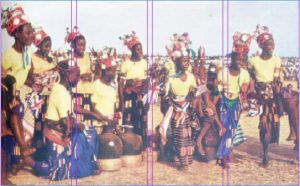

Forward came two Nigerians with chocks for the wheels and next brought were the landing steps. Then the door of the aircraft was opened and they saw the Queen!
What a wonderful moment! For today’s women, it was on record that the Queen wore a deep rose-pink and white printed silk frock with a wide-brimmed pink straw hat which had a scarlet crown. Her peep-toe sling-back shoes were white.
Governor-General and Lady Robertson were there at the foot of the steps to meet the Queen and the Duke, a handsome figure in his tropical naval uniform with the broad blue sash of the Order of the Garter across it.
Then the Queen met the leaders of the three Armed Services and walked across to the salute base to receive the tribute of the Nigeria Regiment’s Guard of Honour. Next the Queen met a group of very important persons including the Federal ministers.
She also had a word for everyone and enjoyed a joke with Chief Samuel Ladoke Akintola, leader of opposition in the Federal House, while the Duke was obviously fascinated by the 20-foot long train and ostrich-feathered straw of Chief Festus Okotie-Eboh, Federal Minister of Labour and Welfare.
Then the Royal procession moved from the airport on its way to Government House. The greeting of the crowd was enthusiastic, especially that of the children who gathered with their school banners. Some merry groups of boys had brought their drums along.




The procession stopped at a special pavilion just past Yaba roundabout. Here, the Oba of Lagos, Adeniji Adele II, as President of Lagos Town Council, presented a royal address to Her Majesty and the Queen replied.
There was a charming touch when little Folasade Lawson, daughter of the council’s chairman, walked with complete and self-consciousness across the road and up the steps to the dais to present the Queen with a bouquet. Her complete calm won the delighted applause of the crowd.
The Queen then made a speech, thanked the chiefs and people of Lagos for their warm and friendly welcome. She and her husband, she told the crowd, were glad to be among the people of Lagos.
The procession thereafter left the roundabout and made its way through the cheering crowd to Government House. Never had Lagos seen such scenes of enthusiasm!
Dinner With The Queen
After the morning and afternoon ceremonies, the Queen took a long rest in preparation for her dinner with Nigerian leaders. And at 8 p.m., leading personalities in Nigeria entered the Government House as guests of Her Majesty.
The dinner was held in the dining room illuminated by pink light with 32 Nigerian stewards in attendance, wearing white uniform with two rows of brass buttons and red cummerbunds.
The menu was clear oxtail soup, gilled barracuda, chicken with mushrooms, pears and fried potatoes, Nigerian ice cream with pawpaw, pineapple and peaches and coffee. A pleasant table effect was provided by a display of blushing hibiscus.
At the head of the table was the Governor-General, Sir James Robertson, while on his right was the Queen and on his left was the Duke. On the lawn outside, the Nigerian Police Band was playing.
The Queen wore a dress of sky-blue satin with fitting bodice, a V-neckline and narrow shoulder straps. It was embroidered in stones of blue and pink leaf, with sparkling paillettes. The dress was full skirted, but most of the Nigerian guests wore traditional costumes.
In attendance at the function were Lady Robertson and Miss Carol Robertson; Mallam Abubakar Tafawa Balewa, Minister of Transport); Mazi K. O. Mbadiwe, Minister of Communication and Aviation; Mr. Kola Balogun, Minister of Research and Information and wife; Chief Festus Okotie-Eboh, Minister of Labour and Welfare and wife; Alhaji Inua Wada, Minister of Works; Mr. Aja Nwachuku, Minister without Portfolio; Mr. Victor Mukete, Minister without Portfolio and wife; Sir Stafford Foster-Sutton, Chief Justice and; Sir Frederick Metcalfe, Speaker and wife; Sir Maxime de Commarmond, Chief Justice of the High Court of Lagos and wife; Mr. R. F. A. Grey, Chief Secretary of the Federation and wife; Chief Samuel Ladoke Akintola, Leader of Opposition and wife; Sir Samuel Manuwa, Chief Medical Adviser to the Federation and wife; Sir and Lady Kofo Abayomi, Mr. A. Mckisack, Attorney General and wife; Mr. G. G. Carlyle, Acting Financial Secretary of the Federation; Most Rev. J. L. C. Horstead, Archbishop of West Africa; Rt. Rev. A. W. Howells, Bishop of Lagos and wife; Archbishop Leo Taylor, the Countess of Euston, Lt.-Col. Sir Michael Adeane, the Queen’s Private Secretary; Mr. D. J. Brown, the Governor-General’s Private Secretary; Capt. S. A. Ademulegun, ADC to Major J. T. U. Aguiyi-Ironsi, the Queen’s Equerry; Vice Admiral Sir Lan Campbell, Commander-in-Chief, South Atlantic; Lieutenant-General Sir Otway Herbert, GOC, West Africa Command and Air Marshall Sir Harry Broadhurst, AOC-in-C, Royal Air Force Bomber Command.
That was how it all began. The Queen spent four days in Lagos, where she worshipped with Nigerians at the Cathedral Church of Christ, visited the sick at Igbobi Orthopedic Hospital, addressed members of the Nigerian Parliament and hosted a thousand guests at Royal Party.
After these, on 1 February, 1956, Her Majesty and the Duke of Edinburgh, preceded by two motorcyclists and several other cars behind, arrived at the Ikeja Airport at 8.55 a.m., where she inspected another Guards of Honour, enjoyed the music of the Police Band and then escorted into a waiting aircraft. She was on her way to Kaduna, the capital of the Northern Region, on what she called a “voyage of discovery.”
And Kaduna Was Agog For The Queen
Surely, the Queen could never, in all her world travels, have seen such a remarkable sight as what she witnessed at Kaduna on Wednesday, 1 February, 1956, when 4,000 horsemen from all over Northern Nigeria lined the route from the airport to town.
The sight was one which almost defied description. It was a sight to make a Hollywood film producer green with envy. Horses were all covered with gaudy trappings of leather and beads, while riders themselves were a seething mass of colour. There were mounted musicians, some with six-foot long local trumpets made of horns.
There were drummers, beating out their compelling rhythms of welcome to the Queen from over the sea. Some of the horsemen carried three-pronged spears, while others brandished swords.
What a sight it was! One noticed the Emir of Kano’s jester, a comic figure in sheep skins. There were the shrilly crying women, the boys playing reed pipes, while there was also a group of masqueraders, their heads hidden in bizarre straw masks.
Amidst this incredible array, the Queen was driven in her gleaming Rolls-Royce car with the Duke in the uniform of a Marshal of the Royal Air Force at her side. They paraded along the route where smart Nigerian troops and school children stood, all in white.
Here and there, among the horsemen, one saw a European official or two, who had ridden hundreds of dusty miles to Kaduna with their groups.
Earlier, at the airport, the scene was also magnificent, although the only music was that of regimental band as compared to blaring trumpets, reed pipes and drums of procession route.
As the Queen stepped from the Royal Viking, Governor and Lady Sharwood-Smith stepped forward to welcome her and the Duke. The Queen walked on a red carpet, which labourers with twig brooms had been keeping clear of dust. In a special pavilion, the Royal visitors met leading Northern personalities, including the Premier, Sir Ahmadu Bello, and other Regional ministers.
Octogenarian Shehu of Bornu had been one of the first to arrive some three hours before. The venerable looking figure wearing spectacles was gently assisted by the governor to be presented to the Queen.
Remarkable Contrast
The Duke with his uncanny knack of making the most nervous feel at ease, had a word for everybody.
Contrasting with bright gowns and head dressers of other ministers was the sober black suit and clerical collar of Pastor David Lot.
After the busy Lagos with its crowded streets and noisy traffic, the Queen must find Kaduna a remarkable contrast. Northern Nigeria can be proud of the magnificent show it put up, making one feel it was the real thing.
If the horsemen that welcomed the Queen had thrilled her, then the Durbar arranged for the Royal visit practically enthralled her. The Durbar scene was one which no film producer could ever hope to emulate and one which left commentators gasping and reporters searching for adjectives, descriptive enough to convey the dazzling splendour and magnificence of it all.
All through the night, drums, trumpets and pipes had been playing in the Durbar camp and their insistence, all-penetrating clamour, spiced the early morning air as spectators and participants gathered at Kaduna Race Course.
Just before the Queen arrived, it was announced over a public address system that she would be wearing a tiara and evening dress and there was a mighty roar of approval from the crowd.
Her Majesty’s car was accompanied by a guard of mounted Native Authority policemen with pennants flying from their lances.
From the Royal Pavilion, the Queen’s view covered half a mile arc of variety and colour. To her left were thousands of her peoples; in front of her in the middle distance were provincial contingents with here and there an emir’s gay umbrella jerking and gyrating as it was whirled around by a faithful attendant.
Each provincial group had its own predominant colour so that it was as if the Queen was seeing a human rainbow. To her right were men of the Nigeria Regiment in their khaki uniform with scarlet waistcoats and beyond them high tower for cameramen.
In the nearer foreground were groups of Jahi horsemen waiting to carry out their special display at the end of the Durbar and at the immediate side of the Royal pavilion were press photographers and news men, who in the succeeding two hours, were to see sights unequalled in all their vast experience.
Eight native authority bands were on parade too, with the guard of honour mounted by the Nigeria Regiment. The Queen, driving around in a Rolls Royce car, inspected ranks of assembled provincial contingents consisting of 2,000 horsemen and 4,000 men on foot. Then she returned to the Royal pavilion and the great cavalcade moved forward like never ending pageant of history across the dusty, yellow-grassed Durbar ground.
The scene almost defied description for it was so colourful and varied, with so many fascinating items clamouring for attention.
First came nearly 400 men from Plateau Province, led by five chiefs. In procession came a merry tumbler performing his antics for the Queen. Then were drummers dressed in leopard skins and dancers whose whole bodies wriggled and squirmed and writhed as they passed before her Majesty.
Next came 250 men on foot representing the Kabba Province with members of the unconquered and unconquerable Igala tribe.
Following them were nearly 600 men, some on foot and others mounted on horseback, from the Benue, whose leaders included the 84-year old Emir of Nasarawa. Among the Benue people were musicians wearing gold colour waist cloths.
One leader, the Emir of Idoma, fell from his horse a yard or two before reaching the Queen, but resumed his seat in saddle without injury.
Two hundred and eighty five men from Ilorin Province including the 70-year old Emir of Ilorin on horseback, tumblers rolled in the dust, one man almost spinning on his head.
Constantly, came the raised hands of salute from mounted horsemen.
Niger Province had 400 men on parade, brighter being the spear men clad in crimson, who waved their spears in greetings as they passed the Queen.
From Zaria came contingents led by five chiefs including the Emir of Zaria, while Kastina Province included the Emir of Katsina.
Being led along in the 100-strong Katsina contingent were the Emir’s eight white Polo ponies, on one of which was ridden the Emir’s young son. There were also riders in helmet, whose splendour was a reminder that Katsina Province, including Daura Emirate, traditionally, was the birthplace of the old Hausa state.
The Adamawa Provincial contingent of 100 horsemen and 400 men on foot contained tribesmen who had come over 600 miles to greet their Queen, while Bauchi Province’s large contingent had a number of remarkable features including led camels.
In their group too were a number of women including two mounted on brilliantly arrayed ponies.
On and on, swept this mighty cavalcade, with its salutes and greetings for the Royal couple. Each leader would come forward from the main procession to raise his hand in welcome to the Queen. From Kano Province came 500 horsemen with 1,200 on foot.
The Emir of Gumel rode a fiery steed which reared and pranced before the Royal pavilion. The Emir of Kano had a colourful retinue, while music blared from elephant tusk trumpets.
Five emirs led the 800-strong contingent from Bornu, one of them, the Emir of Fika, who, in spite of his years (he was probably nearly 80 years old), rode a spirited horse and brandished a two-pronged spear with vigour and enthusiasm when passing Her Majesty. And, of course, there was the 82-year old Shehu of Bornu, who left the pavilion to ride by with his men, headed by two outriders bearing blue and orange flags. Following him was gorgeously attired cavalry, brandishing spears and lances.
To end the procession came 500 horsemen and 1,200 men on foot from the Sokoto Province, their leaders being white-robed Sultan of Sokoto and emirs of Gwandu, Argungu and Yauri.
The Sultan, like the Shehu, had been on the Royal dais for the earlier part of the procession.
He rode by in a mass of cavalry men, each row clad in different colours.
And so ended this incredible panorama, which will be remembered and talked about for generations.
Then came the display by the Jahi horsemen, who galloped forward across the arena to rein their horses at a white line, 20 yards from the Royal pavilion. Indeed one group rode with such speed that their leader came well over the white line, the riders pulling their mounts to standstill within a very few feet to the Queen.
One Jahi horseman fell and was carried off by soldiers but after treatment for bruises, he was able to return to his comrades at the Durbar camp.
On 6 February, the Queen left Kaduna with numerous stories of wonders to relate and moved on to Enugu. She was seen off by the Premier, the Sultan and notable emirs of the region, while in Enugu, people were waiting for the Queen and when she met Dr. Nnamdi Azikiwe, the story had a different side.
The Queen and Zik! These two great personalities met for the first time at Enugu Airport.
It was a great moment for Easterners when their Premier, Dr. Nnamdi Azikiwe, met Her Majesty. Azikiwe was visibly moved; in fact, his usual aplomb seemed to desert him for a moment as he shook hands with the Queen, who was in a lemon colour frock and a matching hat. The Duke wore the tropical uniform of a Marshal of the Royal Air Force.
Because the Queen and her entourage arrived Enugu late and the Canberra jet bombers which staged a fly past even more late, the Royal party was delayed for some minutes at the airport.
Sir Clement Pleass, the Governor of Eastern Nigeria and wife welcomed the Queen and the Duke. He introduced Dr. Azikiwe, the Eastern ministers, the Chief Justice, Mr. Justice A.J. Ainley; the Deputy Governor, Mr. C.J. Mayne and the Commissioner of Police, Mr. F. Hodge.
There was also a surprise presentation, although not on the official programme, of Professor Eyo Ita, Leader of Opposition.
Inspection Of Guard Of Honour Mounted By Third Battalion, Nigeria Regiment
The scene was typical of airport receptions on this Royal tour. The Royal aircraft in the background, the Queen in a summer frock, the Duke in uniform, Nigerian soldiers and bandsmen standing proudly erect, a crowd of attentive spectators and above all, the sun shining down on the scene of a happy welcome.
For the first time of the tour, the Royal car was driven by a Nigerian, Lance Corporal Wilfred Hart, of the Nigeria Police. He served in Burma and in the North.
It was unfortunate that the Royal car was a closed Rolls Royce, as against others previously used, which were open.
The reason given was that the open car used in the North belonged to the Northern Nigeria Government and if the open car used in Lagos was employed in Enugu, it would not return to Lagos in time for the next events there.
Thousands of people lined sections of the six-mile route to Government House.
“Welcome to the East” and “God save the Queen” were the two most heard slogans shouted. Children were there en masse with their school banners, waving proudly in front of them.
Damage done to flags and bunting by overnight rain created a problem in the morning as so many of the poles were washed away, but workers struggled valiantly to repair Enugu’s gay look as much as possible.
Although there was a garden party attended by more than 1,000 guests in the afternoon, the real thrill for the Queen was on 7 February, 1956, when her Majesty saw the Easterners in their dancing gaits. The Enugu Stadium was jam-packed for a dancing display before the Queen with some 25,000 to 30,000 people in attendance.
By noon, three quarters of the stands which were meant to hold 14,000 were filled with unauthorised people and in addition, 4,000 children who were originally to line the route were allowed in the stadium instead.
Groups of Performers
Premier of Eastern Nigeria, Dr. Nnamdi Azikiwe, sat at the front of the dais with the Queen to explain to her the various dances.
The first group of performers comprised energetic Kalikpo acrobats who, in their straw skirts and horn- headed dresses, gyrated and tumbled upon grass in front of the Queen.
Then came the merry boys of St. Mary’s Practising School, Agulu, in Awka. Their average age was eleven. They wore multicoloured raffia skirts and knee frills with red and green feather-headed dresses. Theirs was a rhythmic, youthful dance, full of vigour and fun.
The Women
Next came the women from Umuana, Onitsha, in a rarely seen dance full of quick but graceful movements. They brought their own “choir,” who became carried away by the fervor of the dance and they themselves swayed to its compelling rhythm.
Their red plush skirts were a perfect foil to the blue and gold embroidered blouses. They also wore coral anklets.
The boy dancers from Bonny took the stage next and in their dance, they featured Union Jack. Their gay-headed dresses contained many pocket mirrors which flashed in the sunlight.
Rounding off the show were the Ihetenansa girls in a lively performance. They came from Orlu. Their brief attire was of red velvet and were delightfully symbolic of youth and grace.
The Queen and the Duke then retired to the enclosure to meet the leading members of the East Local Authorities.
One thing about Enugu in 1956 was that it was a point of big revenue generation for the Queen because of its coal and that was why they called it the Coal City. Now, the Queen and the Duke insisted “we must visit the coal mine” and off they went.
When they arrived the door step of the first house of the Udi Siding Coal Corporation Housing Estate the previous day, she asked the house owner, Mr. William E. Ejimofor, “can I come in?” while Ejimofor gladly replied: “Yes, your Majesty.”
The Queen then went in and looked round the parlour where Ejimofor stood with his wife. The Queen asked him how long he had been working in the mines and answered it had been since 1928.
On the walls of his parlour hung large portraits of the Queen and the Duke of Edinburgh, while on a cupboard stood a large carving of a cock painted on the right wing with a flag, the symbol of the NCNC.
The Queen then left for an inspection of another house on the estate.
Earlier, when Her Majesty visited the Udi Siding Welfare Clinic, there were 56 nursing mothers sitting there with their children awaiting medical attention. One of them, Mrs. Juliana Uweke, had with her, a set of triplets and a set of new-born twins.
Nearly all the children were yelling furiously as the Queen entered as their mothers stood to salute her with their Union Jack in their hands.
Routine treatment then commenced and Her Majesty showed keen interest as the babies were weighed and then given prescribed drugs for their various ailments.
An average of 3,000 cases per month were recorded in the 13 welfare clinics run by Coal Corporation in the Coal Camp for the wives of the miners. Six of the clinics were for antenatal cases and seven for infant welfare. Five African nurses and one nursing sister were in charge. Attendance was once a week and Dr. A. Kalunta visited the clinics once a week in rotation to attend to difficult cases.
There were miners on the whole estate and their average monthly wages ranged between £13 and £14.
When the Queen arrived at the door step of a clinic, Lady Pleass, wife of the Governor of the region, presented Mrs. C. C. Emmett, supervisor of the clinic and wife of Chairman of the Coal Corporation.
Also presented to the Queen were Mr. E.J. Scanlon, Welfare Officer; Personnel Manager, Dr. Kalunta and Miss E.A. Akpom, Welfare Officer.
The second house on the Coal Camp Estate visited by the Queen was occupied by a hauler, Mr. O. Onoh, aged 32 years. He was married and had three children.
Mr. Onoh had worked in the mines for 19 years and had spent four years in the house in which Her Majesty met him the previous day.
Duke Crawled Through Enugu Coal mine
The Duke of Edinburgh had descended 4,500 feet below surface to see conditions under which more than 2,000 miners were working at the Iva Valley Coal Mine at Enugu the previous day.
There was no mechanical transport for the journey to and fro the mine and as such, the Duke and those who accompanied him had to trek about four and a half miles within one hour.
At one point near the coal face, the Duke had to crawl for about 100 yards. It was physically impossible for anyone to stand erect and the dexterity with which he negotiated the distance impressed all the miners present.
Quick Change
One of the highlights of the visit was the swiftness with which the Duke, on arriving the mine office, changed from his blue tropical suit into miner’s overalls. As he emerged in an overall and a white cap to begin the journey down the mine, delighted Nigerian miners ran into positions along the route to catch a glimpse of him.
On the way down, the Duke spoke to bearded Raphael Onwujale, who joined the colliery in 1945 and was now senior underground foreman. The Duke asked him the nature of his job and how he felt working underground.
He also spoke to another senior underground foreman, 41-year old six-foot-four H.C. Agwuegbo, who was an ex-sergeant of the Royal West Africa Frontier Force. He asked Agwuegbo whether his height was not a source of inconvenience to him in the mine. Laughing, Agwuegbo said he had got used to it.
One interesting moment was when the Duke came across Ozomena, who could only express himself in disjointed Pidgin English. He felt that he might not understand him and so was shying away while the Duke was talking to him. The Duke put him at ease with his usual suave manner and the whole place was full of laughter while Ozomena continued bellowing forth Pidgin English.
Ozomena, timber artisan, had been with the colliery for more than 30 years.
The Duke also spoke to James A. Agu, who joined the colliery in 1930 and was now an artisan grade one and Samuel Roso too, who joined in 1952.
Earlier, Mr. C.C. Emmett, Chairman of the Nigerian Coal Corporation; three Board members, six officials, Mr. E.A. Bassey, President of the Nigerian Coal Miners’ Union and Mr. I. K. Ihejeto, General Secretary, had been presented to the Duke.
The Duke spoke to Mr. Bassey, who himself was a miner and asked questions about the union.
Bassey told him that members on roll totalled 3,000. Regarding his own progress, Bassey said that he joined the colliery in 1946 and was now an artisan grade two.
Mr. Ihejeto told the Duke that he was not a miner but a full-time official of the union, who took over the secretariat two years ago.
After the tour, the Duke took a bath before leaving the mine office.
From the East, it became the turn of the West. The Premier, Obafemi Awolwo, was eager to meet the Queen, while she was also anxious to meet him. The Western Nigeria Government had earlier declared February, 11, 13 and 16 public holidays throughout the region in connection with the Royal visit.
The Queen’s Rolls Royce had taken part in the series of rehearsals and already driven round the routes in the town in expectation of the monarch. And when Her Majesty arrived this day, Ibadan was agog. The eight-year old daughter of Chief Obafemi Awolwo, Tokunbo, met the Queen and presented her with the bouquet after which they drove to the Government House and Awolowo drank tea with the Queen.
The Queen and the Duke of Edinburgh took tea in the drawing room of Government Lodge with the Governor and Lady Rankine; the Premier, Chief Obafemi Awolowo and wife; Chief Justice and Mrs. Ademola; Deputy Governor and Mrs. Shanklaud and the Alake of Abeokuta, Sir Ladapo Ademola II, who received the accolade two days earlier.
Then there was the Royal Garden Party where more than 1,500 people drawn from all parts of Western Nigerian and Lagos attended on the lawns of Government House, Ibadan. Many people were presented to the Queen and the Duke of Edinburgh at the occasion.
As the guests were arriving on the lawns, the Queen and the Duke moved out of their apartments in Government House into the drawing room.
Accompanied by the Governor of Western Nigeria, Sir John and Lady Rankine, the Queen and the Duke then moved into the specially prepared lanes on the lawns and went round, speaking to and shaking hands with many of their loyal subjects. It was here that the Timi of Ede demonstrated his prowess on the talking drum.
The Queen and the Duke watched demonstrations of the Yoruba talking drum and dancing in Government House, Ibadan, after dinner.
Oba John Adetoyese Laoye, the Timi of Ede, a great exponent of talking drums, had travelled 60 miles from his domain to direct the demonstrations. With him were drummers, singers and dancers, specially invited to take part in the performances.
Before it began, Oba Laoye had the honour of dinning with the Queen and the Duke. He explained that talking drums had a deep meaning to the Yoruba.
The Queen and the Duke were thrilled as messages whispered into the ears of the Timi and conveyed by drums to messengers standing several yards away, were promptly carried out.
Before becoming the Timi of Ede, he was a chemist and druggist and had on the previous Saturday, been decorated with the Queen’s Medal for Chiefs at an investiture at Ibadan, for his outstanding services to the people of Ede.
The 56-year old monarch had employed a 46-year old drum for the demonstration.
Then followed Yoruba dancing.
Worshippers of the god of thunder (Sango), demonstrated their special dance called lanku, which was remarkable for its beauty and grace.
Women of over 70 years of age also demonstrated a royal dance, the type of which is fast disappearing in the Yoruba society.
After a visit to the University of Ibadan, the University College Hospital (UCH) and many other important places, then came the biggest event in Ibadan, when the Queen visited and commissioned the West Parliament Building.
Commissioning
The new Western Nigerian Parliament Building was commissioned in Ibadan by the Queen with a golden key which was later handed to the Ooni of Ife, President of the House of Chiefs, to be kept as a memento.
There was no ceremony inside the House, the Queen only went round both Chambers and then by lift with the Duke of Edinburgh to the top floor.
The Royal couple appeared on the balcony high up above, watching the crowd, while the Duke took an animated note of the wide vista of Ibadan visible from his vantage point.
The day, however, seemed to be a sad one for the people of Ibadan as they sensed that the Royal visit was nearly over.
The crowd gathered around the Parliament Building was quieter than it had been and it was as if they wished to pay a quieter, deeper sort of tribute to the Queen, demonstrating how sorry they were to see her go. The Queen was going back via Ijebu Ode and Sagamu.
Thousands of school children lined the route singing Kaabo, kaabo, Elisabeti, kaabo, as the Queen and the Duke drove from Ibadan to Lagos through Ijebu Ode and Sagamu.
It looked like another “youth rally” for the children, many of who had trekked miles from the interior of Western Nigeria to the roadside.
The Royal procession started from Government House, Ibadan at 10.30 a.m. and passed through cheering crowds on both sides of Ogunmola Street, through Bere Square by Mapo Hall, Isale Ijebu on to Ijebu Ode road.
In the royal procession were the Governor, Sir John and Lady Rankine, Chief Obafemi Awolowo, the Premier and his wife.
Royal Visit Thrilled Ijebu People
The Queen and the Duke of Edinburgh called at Ijebu Ode on their way back to Lagos from Ibadan. It was a big day for the people, whose love of pageantry and fan fare surpassed anywhere in Western Nigeria.
The men and womenfolk, who had turned out in costly traditional costumes at the Itoro Hall, where the main reception took place, presented a picturesque scene.
The Awujale, the traditional ruler of the Ijebu people, wore a costly garment made of beads and estimated to have cost about £1,000. So were all the Chiefs and Obas from the neighbouring towns, bedecked in colourful headgears and costly traditional costumes.
As the royal car entered the town, it was greeted with shouts of welcome from school children who were playing bands and singing welcome songs. The route to the Itoro Hall was lined by more than 50,000 people, most of who carried cloth and paper flags.
At the Itoro Hall, the Awujale; Chief T.A. Odutola, the Ogbeni-Oja and Chairman of Ijebu Ode Divisional Council; Oba Osiyemi Fibigbade, the Ebumawe of Ago-Iwoye; Canon S.A. Banjo, Deputy Speaker of the Western House of Assembly and his wife; Mr. B.K. Cooper, Divisional Adviser and wife, were presented to the Queen and the Duke.
After this, the Queen and the Duke drove to the Residency, where Mr. A.J. Philips, the Provincial Adviser and his wife were presented by the Governor. Here Her Majesty and the Duke took lunch.
After a short rest, the Queen and the Duke continued the journey to Lagos, passing through Odogbolu and Ikenne.
On arrival at Sagamu, they stopped for a short ceremony. Here, Oba M.S. Awolesi, the Akarigbo of Ijebu-Remo and President of Ijebu-Remo Divisional Council; Oba Babington Asaye, the Ologere of Ogere and Chairman of Ijebu-Remo Divisional Council; Oba Adetunji Aiyeola Afola II, the Ewusi of Makun and Oba Samuel Akinsanya, the Odemo of Ishara, were presented by the Governor. Both the Queen and the Duke spoke to each one of them.
The Governor and the Premier later escorted the Queen and the Duke to Ikeja boundary before returning to Ibadan.
Back in Lagos again, the people trooped out, just as if the Queen had just arrived. While the Royal Visitor was rounding off her visit, the Oba, Chiefs and other Lagosians were planning the popular Eyo Festival, called Adamu Orisa, and it happened when the Queen was on her way out.
The Adamu-Orisa play was a success, bringing out, as it did, all the colour and magnificence that went with the traditional burial rites of a great man in Lagos.
By late afternoon, Balogun and Victoria Streets were still crowded with people who had come to witness the rare play and also to bid farewell to the Queen and the Duke.
The main attraction were the Eyos of the Adamu group, the Eyo Oniko, Eyo Ologede and Eyo Bajulaye, who were attired in white flowing robes and colourful hats.
Later, the huge crowd assembled before the Palace of Oba Adele II, where the closing scenes of the show were performed.
Many Lagos personalities took part in the play. Among them were Oba Adele II, Sir Kofo Abayamo and Dr. Akinola Maja.
And while they were, still savouring the uncommon spectacular provided by the play, the Queen was already at the Airport, inspecting the Guards of Honour, listening to the music of the Police Band, saying good bye to the Governor-General, Ministers, Obas and very important persons before boarding the BOAC plane, amid heavy musical works by various entertainers.
The Queen climbed the steps majestically, and then stopped. She turned back. With an appreciative smile that was immediately infectious, she waved. And she entered. It now dawned on every one: Queen Elizabeth had gone.
